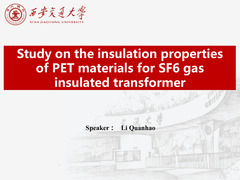报告详情
Study on the insulation properties of PET materials for SF6 gas insulated transformer
编号:172
访问权限:仅限参会人
更新:2022-08-29 12:00:17 浏览:157次
口头报告
摘要
This paper constructs the aging model of SF gas-solid composite insulated transformer (GIT). The nondestructive evaluation of insulation state is realized by combining the analysis of frequency domain dielectric spectrum(FDS) and physicochemical characteristics.
Experimental/Modeling methods
PET film which is the winding insulation material in GIT was aged for 96h, 192h, 288h and 384h respectively at 150℃ in SF6 atmosphere. And then we measured FDS, DSC and NIRS characteristics of PET materials under different aging time respectively.
Results/discussion
Through the detection of PET materials with different aging degrees, it was found that the crystallinity of PET film rose in the early aging stage, and decreased with the aging process. At the same time, through FDS detection, it was found that the dielectric relaxation of PET material also increased first and then decreased with aging, as shown in Fig.1. It is speculated that the change of dielectric properties is related to crystallinity. In the early aging stage, the crystallinity increased, leading to the reduction of interface in PET film and weakening of dipole steering ability. Thus, dielectric loss of the material reduced. In the later stage of aging, molecular chains broke up to form smaller groups of molecules, and the polarization of the film interface increased, leading to the increase of loss. In contrast, with the aging process, the near-infrared spectra (NIRS) characteristics of PET films tend to increase. This is mainly caused by the change of material absorbance, as shown in Fig.2.
Conclusions
As a nondestructive testing method, the polarization loss peak of FDS can be used to characterize PET materials. At the same time, assisted by NIRS technology, it can more accurately realize the local identification of GIT.
Appendix (Figure, table, image…)


Fig.1 The dielectric spectrum of 0.5mm Fig.2 NIR spectra of 0.5mm PET
PET changes with aging time at 60℃ at different aging times
Experimental/Modeling methods
PET film which is the winding insulation material in GIT was aged for 96h, 192h, 288h and 384h respectively at 150℃ in SF6 atmosphere. And then we measured FDS, DSC and NIRS characteristics of PET materials under different aging time respectively.
Results/discussion
Through the detection of PET materials with different aging degrees, it was found that the crystallinity of PET film rose in the early aging stage, and decreased with the aging process. At the same time, through FDS detection, it was found that the dielectric relaxation of PET material also increased first and then decreased with aging, as shown in Fig.1. It is speculated that the change of dielectric properties is related to crystallinity. In the early aging stage, the crystallinity increased, leading to the reduction of interface in PET film and weakening of dipole steering ability. Thus, dielectric loss of the material reduced. In the later stage of aging, molecular chains broke up to form smaller groups of molecules, and the polarization of the film interface increased, leading to the increase of loss. In contrast, with the aging process, the near-infrared spectra (NIRS) characteristics of PET films tend to increase. This is mainly caused by the change of material absorbance, as shown in Fig.2.
Conclusions
As a nondestructive testing method, the polarization loss peak of FDS can be used to characterize PET materials. At the same time, assisted by NIRS technology, it can more accurately realize the local identification of GIT.
Appendix (Figure, table, image…)
Fig.1 The dielectric spectrum of 0.5mm Fig.2 NIR spectra of 0.5mm PET
PET changes with aging time at 60℃ at different aging times
关键词
GIT,PET,FDS,crystallinty,NIRS
报告人

Quanhao Li
Xi'An Jiaotong University稿件作者
全部评论
重要日期
-
会议日期
09月25日
2022
至09月29日
2022
-
08月15日 2022
提前注册日期
-
09月10日 2022
报告提交截止日期
-
11月10日 2022
注册截止日期
-
11月30日 2022
初稿截稿日期
-
11月30日 2022
终稿截稿日期
主办单位
IEEE DEIS
承办单位
Chongqing University
联系方式
- Zhengyong Huang
- 61******@qq.com
历届会议
-
2020年09月06日 中国 Beijing
2020 IEEE International Conference on High Voltage Engineering and Application -
2018年09月10日 希腊
2018 IEEE International Conference on High Voltage Engineering and Application -
2016年09月19日 中国 Chengdu, China
2016 IEEE International Conference on High Voltage Engineering and Application



发表评论